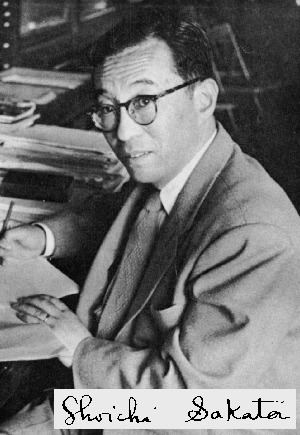Native name 坂田 昌一 Role Physicist Nationality Japan | Name Shoichi Sakata | |
 | ||
Born January 18, 1911Tokyo ( 1911-01-18 ) Died December 16, 1970, Nagoya, Aichi Prefecture, Japan Notable students Makoto Kobayashi, Toshihide Maskawa | ||
Shoichi Sakata
Shoichi Sakata (坂田 昌一, Sakata Shōichi, 18 January 1911, near Hiroshima – 16 October 1970) was a Japanese physicist who was internationally known for theoretical work on the structure of the atom. He proposed the Sakata model, which was an early precursor to the quark model.
Contents

After the end of World War II, he joined other physicists in campaigning for the peaceful uses of nuclear power.
Career
Between 1929 and 1933 Sakata studied physics in Tokyo under Yoshio Nishina and later at the Kyoto Imperial University under Hideki Yukawa, the first Japanese Nobel laureate. He first met Yukawa at Rikagaku Kenkyūsho in Ōsaka, a private research foundation started by Yukawa. Here he worked with him from 1937 on meson theory and in 1939 accompanied him to Kyoto University where Yukawa was a lecturer. Sakata was appointed professor at Nagoya University in 1942 and remained there until his death.
Sakata was a leading Japanese researcher in elementary particles in the 1950s and 1960s, and became well-known outside Japan for his 1956 model of hadrons, later termed the Sakata model, which proposed that the fundamental building blocks of all strongly interacting particles are the proton, the neutron and the lambda baryon. For example, the positively charged pion is made out of a proton and an antineutron. Aside from the integer charges, the proton, neutron, and lambda have the same properties as the up quark, down quark, and strange quark respectively, explaining the model's success.
Sakata's model was superseded by the quark model, due to Murray Gell-Mann and George Zweig, which made the constituents fractionally charged and rejected the idea that they could be identified with observed particles. This leads to the Gell-Mann–Nishijima formula and the eightfold way, which provides the most correct fundamental description. Still, within Japan, integer charged quark models parallel to Sakata's were used until the 1970s, and are still used as effective descriptions in certain domains.
Sakata's model was used in Harry J. Lipkin's book "Lie Groups for Pedestrians" (1965). In 1960, with his Nagoya University associates, he expanded his model to include leptons. Shortly thereafter he developed the Neutrino mixing matrix, a precursor to the currently accepted Neutrino oscillation. In the early 1960s there was already evidence of a second neutrino type.
Influences
The 2008 physics Nobel laureates Yoichiro Nambu, Toshihide Maskawa and Makoto Kobayashi, who received their awards for work on symmetry breaking, all came under his tutelage and influence. The Nagoya Model was the inspiration for the later Cabibbo–Kobayashi–Maskawa matrix of 1973, which specifies the mismatch of quantum states of quarks, when they propagate freely and when they take part in weak interactions. Physicists however, generally attribute the introduction of a third generation of quarks (the "top" and "bottom" quarks) into the Standard Model of the elementary particles to that 1973 paper by Kobayashi and Maskawa.
Kent Staley (2004) describes the historical background to their paper, emphasizing the largely forgotten role of theorists at Nagoya University and the "Nagoya model" they developed. Several of the authors of the Nagoya model embraced the philosophy of dialectical materialism, and he discusses the role that such metaphysical commitments play in physical theorizing. Both theoretical and experimental developments that generated great interest in Japan, and ultimately stimulated Kobayashi and Masukawa's 1973 work, went almost entirely unnoticed in the U.S. The episode exemplifies both the importance of untestable "themata" in developing new theories, and the difficulties that may arise, when two parts of a research community work in relative isolation from one another.
Missed out on Nobel Prize
Shoichi Sakata's "Sakata model" inspired Murray Gell-Mann and George Zweig's quark model, but the 1969 prize was only awarded to Murray Gell-Mann. Afterward, Ivar Waller, the member of Nobel Committee for Physics was sorry that Sakata had not received a prize.
In September 1970, Hideki Yukawa politely wrote to Waller informing him that Sakata had been ill when the nomination was written; since then, his condition had worsened significantly. Three weeks later, Sakata died. Yukawa informed Waller that a prize to Sakata would have brought him much honor and encouragement. He, then, in the name of leading Japanese particle physicists, asked to know what the Nobel committee thought of Sakata's merits, for that would perhaps bring them consolation.
